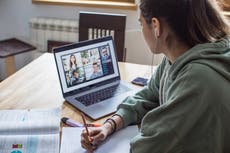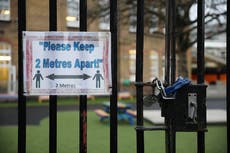‘This could seriously undermine impact of lockdown measures’: Concerns over demand for school places during England lockdown
'We've heard stories of some schools having 50-70 per cent in,' Paul Whiteman from the NAHT says

Your support helps us to tell the story
From reproductive rights to climate change to Big Tech, The Independent is on the ground when the story is developing. Whether it's investigating the financials of Elon Musk's pro-Trump PAC or producing our latest documentary, 'The A Word', which shines a light on the American women fighting for reproductive rights, we know how important it is to parse out the facts from the messaging.
At such a critical moment in US history, we need reporters on the ground. Your donation allows us to keep sending journalists to speak to both sides of the story.
The Independent is trusted by Americans across the entire political spectrum. And unlike many other quality news outlets, we choose not to lock Americans out of our reporting and analysis with paywalls. We believe quality journalism should be available to everyone, paid for by those who can afford it.
Your support makes all the difference.The “sheer demand” for school places during England’s current lockdown has sparked concerns, with a leading education union saying it appeared much higher than last spring.
Fears about the risks of transmission of Covid-19 have been raised amid reports some schools are still welcoming around half – or even more – of their students on site.
Alison Peacock, the chief executive of the Chartered College of Teaching, said she had written to the Department for Education (DfE) "concerned about the numbers of children attending school” as the third lockdown kicked off.
On Wednesday, Gavin Williamson confirmed pupils without digital devices at home can be classed as vulnerable and allowed to continue going to school – which Ms Peacock claimed “threatens the effectiveness of ‘closure’”.
Schools have been moved online for all children until at least mid-February, except for those classed as vulnerable and key workers’ children, as part of England’s new lockdown over the coronavirus pandemic.
Follow the latest news live as figures show Covid cases rose by nearly 25% over Christmas
Boris Johnson warned that schools may act as "vectors for transmission," causing the virus to spread between households as he announced the changes for education resembling last spring’s lockdown.
Paul Whiteman from the school leaders’ union NAHT said: “We're increasingly concerned about the sheer demand for key worker and vulnerable pupil places this week."
“Our members are telling us that demand for places is much higher than it was during the first lockdown last spring. We've heard stories of some schools having 50-70 per cent in.”
The union’s general secretary added: "This could seriously undermine the impact of lockdown measures, and may even run the risk of extending school closures."
He added that it was critical that school places are only taken up by parents "when absolutely necessary" in order to stem the spread of the virus.
The NAHT and the Association of School and College Leaders (ASCL) are both calling on the government to provide guidance on the maximum safe number of children that there should be in school at once.
ASCL – which is also calling for clarity on how schools should prioritise places if they are over this limit – has warned that the demand for places in primary schools has created a "public health concern".
“We are receiving reports of very high demand for places for the children of key workers in primary schools resulting in 50 per cent or more of children being on site in some schools,” Geoff Barton, the ASCL’s general secretary, said.
The education secretary confirmed on Wednesday that students without laptops, desktops or tablets would be able to access education in school during England’s current lockdown, “as in the previous situation where we saw schools [being] closed during the months of March, April and May”.
But headteachers told The Independent it was not explicitly clear in original first lockdown guidance that children without devices could fall under the vulnerable category, and concerns have been raised over what this would mean in practice for school numbers.
Kit Andrew, a primary headteacher in London, told The Independent this classification would “apply to over 50 per cent of my pupils”, on top of more than 25 per cent who are the children of key workers.
Mr Barton from the ASCL said: "As remote education is rarely easy with young children, this has the potential to lead to huge demand.
“This is creating a public health concern as the point of restricted opening is to reduce the number of contacts in order to suppress the risk of coronavirus transmission.”
The DfE said last weekend it had delivered 560,000 laptops and devices to schools to support remote learning, with another 100,000 arriving this week, and was on track to reach its target of one million delivered by the end of the academic year.
According to estimates from Ofcom, between 1.14 million and 1.78 million children in the UK do not have home access to a laptop, desktop or tablet.
A DfE spokesperson said: “Schools are open for vulnerable children and the children of critical workers. We expect schools to work with families to ensure all critical worker children are given access to a place if this is required.
"If critical workers can work from home and look after their children at the same time then they should do so, but otherwise this provision is in place to enable them to provide vital services.”
The DfE spokesperson added: "The protective measures that schools have been following throughout the autumn terms remain in place to help protect staff and students, while the national lockdown helps reduce transmission in the wider community.”





Join our commenting forum
Join thought-provoking conversations, follow other Independent readers and see their replies
Comments